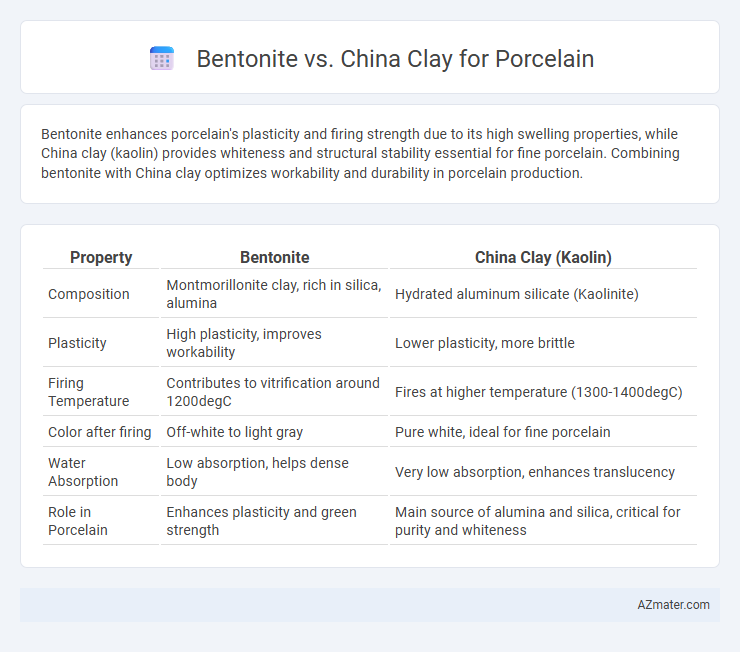Bentonite enhances porcelain's plasticity and firing strength due to its high swelling properties, while China clay (kaolin) provides whiteness and structural stability essential for fine porcelain. Combining bentonite with China clay optimizes workability and durability in porcelain production.
Table of Comparison
| Property | Bentonite | China Clay (Kaolin) |
|---|---|---|
| Composition | Montmorillonite clay, rich in silica, alumina | Hydrated aluminum silicate (Kaolinite) |
| Plasticity | High plasticity, improves workability | Lower plasticity, more brittle |
| Firing Temperature | Contributes to vitrification around 1200degC | Fires at higher temperature (1300-1400degC) |
| Color after firing | Off-white to light gray | Pure white, ideal for fine porcelain |
| Water Absorption | Low absorption, helps dense body | Very low absorption, enhances translucency |
| Role in Porcelain | Enhances plasticity and green strength | Main source of alumina and silica, critical for purity and whiteness |
Introduction to Porcelain Clay Materials
Bentonite and China clay are essential porcelain clay materials, each contributing unique properties to the final ceramic product. Bentonite offers high plasticity and water absorption, improving moldability and enhancing the green strength of porcelain bodies. China clay, also known as kaolin, provides whiteness, refractory qualities, and structural stability, making it a key ingredient in achieving the delicate translucency and durability characteristic of fine porcelain.
What is Bentonite?
Bentonite is a highly absorbent clay composed mainly of montmorillonite, prized for its plasticity and binding properties in porcelain production. Unlike China clay (kaolin), which provides whiteness and strength, bentonite enhances workability and plasticity, improving the shaping and drying processes in porcelain manufacturing. Incorporating bentonite optimizes the ceramic body by increasing its cohesiveness and reducing cracking during firing.
What is China Clay (Kaolin)?
China clay, also known as kaolin, is a fine, white clay primarily composed of the mineral kaolinite, essential in porcelain manufacturing due to its purity, whiteness, and plasticity. Its high alumina content and low impurities contribute to the strength, translucency, and smooth surface of porcelain products compared to bentonite, which primarily serves as a binder and plasticizer. China clay enhances porcelain's vitrification process, resulting in a durable, glossy finish that is highly valued in fine ceramics.
Key Physical Properties Comparison
Bentonite exhibits high swelling capacity and excellent plasticity, making it ideal for enhancing the moldability of porcelain clay bodies, whereas China clay (kaolin) provides superior whiteness, refractory strength, and low impurity levels critical for the final porcelain appearance and durability. Bentonite's fine particle size and high cation exchange capacity improve water retention and plasticity, while China clay's plate-like particle structure contributes to reduced shrinkage and improved mechanical strength during firing. The combination of bentonite's binding properties and China clay's thermal resistance optimizes the porcelain's overall performance in terms of workability, whiteness, and fired strength.
Chemical Composition Differences
Bentonite primarily consists of montmorillonite clay minerals rich in aluminum silicate with a high content of swelling clay minerals and significant amounts of sodium, calcium, and magnesium ions, which influence plasticity and water absorption in porcelain. China clay, also known as kaolin, is mainly composed of kaolinite with a lower amount of silica and alumina, characterized by its non-swelling, inert properties, providing whiteness and strength in porcelain firing. The chemical distinction between bentonite's higher cation exchange capacity and china clay's purity affects the plasticity, vitrification, and final texture of porcelain products.
Role in Porcelain Plasticity
Bentonite significantly enhances porcelain plasticity due to its high swelling properties and fine particle size, allowing better workability and shaping of the clay body. China clay (kaolin), while essential for whiteness and strength, has low plasticity, making it less effective in improving the molding characteristics of porcelain. Combining bentonite with china clay balances plasticity and durability, resulting in a more manageable and high-quality porcelain formulation.
Effect on Firing Temperature and Strength
Bentonite and China clay significantly influence porcelain's firing temperature and strength, where bentonite, a swelling clay, enhances plasticity and reduces firing temperature due to its high flux content, resulting in a denser and more vitrified final product. China clay, or kaolin, provides refractory properties with high firing temperature requirements, contributing to porcelain's whiteness and strength by maintaining shape and structure without excessive shrinkage during firing. The combination of bentonite and China clay balances early firing plasticity and final mechanical strength, optimizing porcelain's durability and thermal resistance.
Impact on Final Porcelain Appearance
Bentonite improves porcelain plasticity and enhances translucency due to its fine particle structure, resulting in a smoother, glass-like surface after firing. China clay (kaolin) provides whiteness and opacity, contributing to the porcelain's strength and a more matte finish. The balance of bentonite and China clay determines the final porcelain appearance, with bentonite increasing translucency and gloss, while China clay maintains opacity and durability.
Cost and Availability Considerations
Bentonite is typically more cost-effective and widely available than China clay, making it a preferred choice for porcelain manufacturers aiming to reduce raw material expenses. China clay, while featuring higher purity and improving the porcelain's whiteness and strength, often comes with a higher price point and less consistent supply due to geographic limitations. Evaluating cost-efficiency alongside the regional availability of bentonite and China clay is critical for optimizing production budgets and maintaining a steady manufacturing workflow.
Choosing the Right Clay for Porcelain Production
Bentonite offers excellent plasticity and bonding properties, enhancing the workability and strength of porcelain clay bodies, while China clay provides a fine particle size and high whiteness essential for achieving the translucent quality in porcelain. Selecting the right clay depends on the desired balance between plasticity, whiteness, and firing temperature; bentonite improves shape retention but can increase drying shrinkage, whereas China clay ensures smooth texture and bright finish with moderate plasticity. Optimizing these clays in specific proportions allows manufacturers to produce durable, aesthetically pleasing porcelain with optimal firing performance.

Infographic: Bentonite vs China clay for Porcelain
 azmater.com
azmater.com